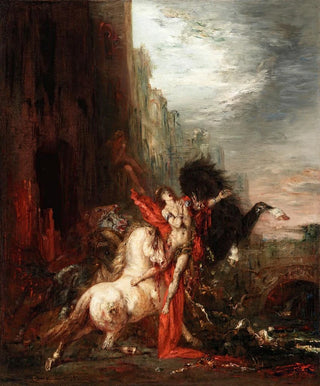Art print | Diomedes Devoured by His Horses - Gustave Moreau


View from behind

Frame (optional)
In the fascinating universe of symbolist art, the "Art print" "Diomède dévoré par ses chevaux" by Gustave Moreau stands out for its evocative power and unique aesthetic. This painting, which immerses the viewer in a complex mythological narrative, embodies both beauty and tragedy. Confronting the figure of Diomède, a hero from Greek mythology, Moreau explores universal themes such as violence, passion, and destiny. The scene, both dramatic and poetic, invites deep contemplation, where every detail resonates with particular intensity. This art print, a true mirror of the human soul, continues to inspire and provoke those who dare to delve into it.
Style and uniqueness of the art print
Gustave Moreau's style is characterized by rich chromaticity and narrative complexity that transcend the simple framework of painting. In "Art print", the vibrant palette, blending warm and cool tones, creates an atmosphere that is both enchanting and unsettling. The forms, often fluid and sinuous, intertwine in a harmonious dance, illustrating the struggle between man and his passions. Moreau skillfully plays with light and shadow, emphasizing the drama of the scene while maintaining a certain lightness. The horses, symbols of strength and savagery, become instruments of Diomède's tragic destiny, offering multiple interpretations of mythology. This art print does not merely tell a story; it invites a sensory experience where each gaze reveals new facets.
The artist and his influence
Gustave Moreau, an emblematic figure of symbolism, managed to mark his era with a unique artistic vision. Raised in an educated environment, he was influenced by the great traditions of European art while developing a personal style that is entirely his own. His approach to mythology, far from conventional, is part of a quest for meaning and emotion, where each character becomes a vehicle for broader reflection on the human condition. Moreau also played a key role in the training of many artists,

Matte finish

View from behind

Frame (optional)
In the fascinating universe of symbolist art, the "Art print" "Diomède dévoré par ses chevaux" by Gustave Moreau stands out for its evocative power and unique aesthetic. This painting, which immerses the viewer in a complex mythological narrative, embodies both beauty and tragedy. Confronting the figure of Diomède, a hero from Greek mythology, Moreau explores universal themes such as violence, passion, and destiny. The scene, both dramatic and poetic, invites deep contemplation, where every detail resonates with particular intensity. This art print, a true mirror of the human soul, continues to inspire and provoke those who dare to delve into it.
Style and uniqueness of the art print
Gustave Moreau's style is characterized by rich chromaticity and narrative complexity that transcend the simple framework of painting. In "Art print", the vibrant palette, blending warm and cool tones, creates an atmosphere that is both enchanting and unsettling. The forms, often fluid and sinuous, intertwine in a harmonious dance, illustrating the struggle between man and his passions. Moreau skillfully plays with light and shadow, emphasizing the drama of the scene while maintaining a certain lightness. The horses, symbols of strength and savagery, become instruments of Diomède's tragic destiny, offering multiple interpretations of mythology. This art print does not merely tell a story; it invites a sensory experience where each gaze reveals new facets.
The artist and his influence
Gustave Moreau, an emblematic figure of symbolism, managed to mark his era with a unique artistic vision. Raised in an educated environment, he was influenced by the great traditions of European art while developing a personal style that is entirely his own. His approach to mythology, far from conventional, is part of a quest for meaning and emotion, where each character becomes a vehicle for broader reflection on the human condition. Moreau also played a key role in the training of many artists,






